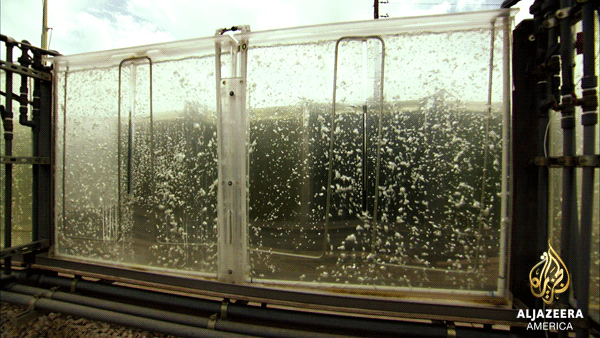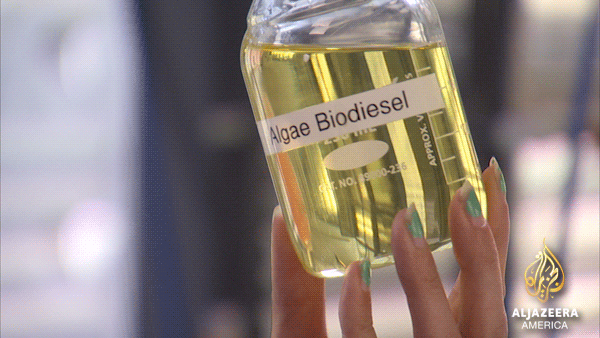The story of modern industrialized society has been one of energy — finding it, harvesting it and developing new technologies to do both more efficiently. As populations and economies have grown, so too has our thirst for energy, primarily oil.
Many people think of oil as fossil fuels — liquefied dinosaurs — but the reality is that most oil actually started off as algae millions of years ago. And in looking to create biofuels, scientists have often seen great potential in farming and harvesting algae. The main problems that have hampered the development of algae have been its startup costs and the challenge of producing algae at a scale necessary to supply our enormous energy needs.
Over the past few decades a wide variety of applications for algae have emerged and are being used commercially right now. It may still be many years before our cars are running on “Arizona crude” — algae grown in desert-based research labs, as seen on this week’s “TechKnow” — but until then, here are five ways this organism is already a part of your everyday life and might be even more pervasive in the future.
FIVE WAYS ALGAE ARE ALREADY IN YOUR LIFE
1. Fish feed
As the human population grows, demand for farmed fish is projected to rise between 80 million and 160 million tons over the next 20 years. Currently most fish feed is made from a combination of fish meal, fish oil, soy and corn; however, algae-based feed is increasingly being used as a substitute. This has several benefits when compared with a crop like soybeans. In addition to being able to be grown year-round, algae consume only about 1 percent of the water that soy does. On top of that, it can produce 38 times more protein per acre per year.
2. Cosmetics
Some strains of algae naturally produce a compound called alguronic acid, which helps protect them from the bright, harsh environments in which they live. One of the major companies involved in the industry, Solazyme, has developed a product called Algenist, which is made primarily of compounds derived from microalgae. The company has successfully put its anti-aging skin care line in 800 Sephora stores in the U.S. and Europe.
3. Dietary supplements
Dietary supplements like omega-3 have traditionally been derived from fish, but with demand already outstripping supply and projected to double over the next 30 years, algae are taking the lead as the main replacement. Numerous companies, including Heliae, produce algae oil for the nutraceutical industry’s products, which can be found on store shelves all over the country. In addition to having an extensive fatty acid profile, algae oil is rich in complex carbohydrates, vitamins, minerals, amino acids and antioxidants.
4. Water treatment
The United Nations estimates that about 1,500 cubic kilometers of wastewater are produced globally each year, with approximately 80 percent going untreated. This water is high in nutrients that algae can feed from rather than being relegated to runoff. There are numerous companies that now offer algae-based water purification for industrial and commercial entities. Algae have been shown to remove heavy metals and toxic substances from wastewater. Recently, a research team from Japan demonstrated that algae can remove radioactive substances as well.

5. Stabilizing agent
Chondrus crispus, also known as Irish moss, is a species of red alga that thrives on the Atlantic coasts of North America and Europe. It is used as a food stabilizer in numerous dairy products including ice cream, eggnog, pudding and chocolate. It can also be used as a substitute for gelatin and as an anti-drying agent in breads and pastries. It is used for manufacturing processed cheese, mayonnaise, creams and jellies. Other products include pet foods and even toothpaste.
FIVE FUTURE USES FOR ALGAE
1. Fuel
Most people know that algae are an exciting possible source of ethanol and biodiesel, but there are other ways it can used to make fuel. Recently, the National Renewable Energy Laboratory published results of testing it has done using algae to generate hydrogen. One of algae’s valuable traits is their ability to grow rapidly, sometimes doubling their biomass in a matter of days or even hours. It may be a bit less high tech, but this organic material can be grown quickly to be burned for heat and electricity generation.

2. Carbon capture
Algae are especially carbon-hungry organisms. A number of companies are looking at them as a possible mechanism for capturing our carbon emissions by feeding the exhaust from power plants and other major polluters to algae.
3. Flour
The algae company Solazyme has also teamed up with the food company Roquette Nutritionals. Together they have created an algae-based flour with a lipid profile similar to olive oil’s. Because of the properties of the flour, when it’s added to various food products, it reduces the amount of fats (i.e., butters and creams) required, thereby lowering the amount of calories while increasing the protein and fiber content.
4. Plastics
In the realm of new materials from algae, plastics have been promising. The Institute for Plastic Technology in Spain last year announced a plan to work toward creating adhesives, paints and dyes using a technology developed by Alicante-based Biofuel Systems. The 42-month research program includes 13 companies.
5. Cancer treatment
Biologists at the University of California, San Diego, announced in 2012 that they had succeeded in engineering a strain of alga to produce a cancer treatment drug. The drug is meant to treat B-cell lymphomas. There is an alternative drug in development that is slated to cost about $100,000 per dose. The goal of the researchers is to create an effective lower-cost alternative.
To learn more about algae, watch “TechKnow,” Saturday 7 ET/4 PT.
Error
Sorry, your comment was not saved due to a technical problem. Please try again later or using a different browser.